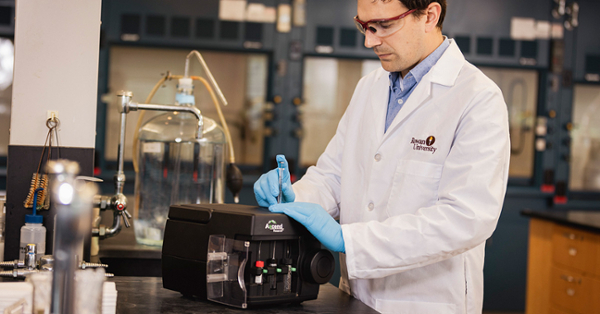NIH grant funds improvement of common form of chemical analysis
NIH grant funds improvement of common form of chemical analysis

Analyzing samples from a crime scene. Looking for evidence of doping at the Olympics. Monitoring environmental contaminants. As different as their aims may be, all these tests rely on two techniques for chemical analysis. Researchers at Rowan University have received a five-year, $1.875 million National Institutes of Health (NIH) grant they will use to make this analytical technology faster and easier to use.
James Grinias, Ph.D., a professor in the Department of Chemistry & Biochemistry, plans to adapt the combination of these techniques, called liquid chromatography–mass spectrometry (LCMS), so they function more like a real-time sensor for detecting chemicals of interest within a sample.
“Compared to other sensing technology, LCMS is slower and a bit cumbersome,” Grinias says. However, he notes, LCMS can detect a much wider range of target molecules.
“We want the best of both worlds: something that’s fast and also very widely applicable,” he says. He is collaborating with other faculty at Rowan, who intend to apply this technology in their own research.
The grant, an NIH Maximizing Investigators' Research Award, will fund his lab’s overall work developing miniaturized technology and solving challenges related to studying complex biological systems. It will also give Grinias and his colleagues the support they need to devise a new LCMS platform.
They aim to develop a smaller, modular system in which the components are connected and automated, speeding up the analysis and making it simpler for the operator. First, a straw-like probe would suck up a sample, such as fluid from tissue in an experiment. The system would then perform a small chemical reaction to modify the sample’s contents, a process called derivatization, to make them easier to track with the LCMS analysis.
The first of these analytical techniques, liquid chromatography, separates the sample’s components, including the molecules of interest, based on their interactions with a liquid solvent and a solid medium. The second, mass spectrometry, identifies these molecules based on the ratio of their molecular mass to their charge.
Grinias’ collaborators include David Devilbiss, Ph.D., an assistant professor in the Department of Cell Biology & Neuroscience at Rowan-Virtua School of Osteopathic Medicine, who studies the neurobiology of traumatic brain injuries, with the goal of developing new ways to reduce the cognitive impairments these injuries can cause. Grinias’ new system would detect neurotransmitters, which are chemical signals brain cells send to one another, in cell models that replicate brain activity.
Meanwhile, Lark Perez, Ph.D., a professor in the Department of Chemistry & Biochemistry, intends to use the system to study bacterial communities known as biofilms by tracking the microbes’ chemical communications.
Ultimately, Grinias anticipates the new technology could be widely used for “almost anything.”
Although the grant does not explicitly support education and training, it will allow the lab to provide new opportunities for undergraduate and graduate students, as well as for postdoctoral associates, Grinias says.
“The students in our research group made this award possible,” he says, “and I am excited at the chance to provide even more research opportunities to Rowan students with this support.”